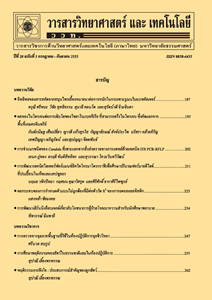สมบัติเชิงหน้าที่ของข้าวไทย : การต้านอนุมูลอิสระและการส่งเสริมการเจริญเติบโตของจุลินทรีย์สุขภาพ
Main Article Content
Abstract
Functional properties of eight varieties of Thai rice (Khao Dawk Mali 105, Khao Tah Haeng, Leuang Pratew, Khao Doi, Purple Rice, Khao Hawm Nin, Sang Yod and Red Hawm) were studied for antioxidant capacity (DPPH radical-scavenging method, ABTS radical cation decolorization assay and total phenolic) and the synergistic effects of probiotic (Lactobacillus bulgaricus TISTR 451, Lactobacillus lactis TISTR 452 and Lactobacillus casei TISTR 453) microorganism growth (turbidimetrically, probiotic cell count and resistant starch content). The result showed that the colored rice have more antioxidant efficiency than the non-colored rice (p < 0.05). Especially, Red hawm rice and Hawm Nin rice were found to have the highest antioxidant capacity compared to the other rice. When synergistic effects of 3 probiotics were studied, the result showed that three probiotics could use the carbon-source from those rice varieties. Leuang Pratew and Khao Tah Haeng rice exhibited the highest synergistic effect of probiotic growth according to the high level of resistant starch content.
Keywords: rice; antioxidant capacity; resistant starch; probiotic
Article Details
References
[2] Shukla, Y. and Singh, M., 2007, Cancer preventive properties of ginger: A brief review, Food Chem. Toxicol. 45: 683-690.
[3] Sun, S.W., Yu, H.Q., Zhang, H., Zheng, Y.L., Wang, J.J. and Luo, L., 2007, Quercetin attenuates spontaneous behavior and spatial memory impairment in D-galactose-treated mice by increasing brain antioxidant capacity, Nutr. Res. 27: 169-175.
[4] Barciszewski, J., Massino, F. and Clack, B.F.C., 2007, Kinetin-A multiactive molecule, Int. J. Biol. Macromolecules 40: 182-192.
[5] Huebner, J., Wehling, R.L. and Hutkins, R.W, 2007, Functional activity of commercial prebiotics, Int. Dairy J. 17: 770-775.
[6] Marinho, M.C., Pinho, M.A., Mascarenhas, R.D., Silva, F.C., Lordelo, M.M., Cunha, L.F. and Freire, J.P.B., 2007, Effect of prebiotic or probiotic supplementation and ileo rectal anastomosis on intestinal morphology of weaned piglets, Livest. Sci. 108: 240-243.
[7] Chung, H.S. and Shin, J.C., 2007, Characterization of antioxidant alkaloids and phenolic acids from anthocyanin-pigmented rice (Oryza sativa cv. Heugjinjubyeo), Food Chem. 104: 1670-1677.
[8] Shao, Y., Hu, Z., Yu, Y., Mou, R., Zhu, Z. and Beta, T., 2018, Phenolic acids, anthocyanins, proanthocyanidins, antioxidant activity, minerals and their correlations in non-pigmented, red, and black rice, Food Chem. 239: 733-741.
[9] Goufo, P. and Trindade, H., 2014, Rice antioxidants: Phenolic acids, flavonoids, anthocyanins, proanthocyanidins, toco-pherols, tocotrienols, -oryzanol, and phytic acid, Food Sci. Nutr. 2(2): 75-104.
[10] Helland, M.H., Wicklund, T. and Narvhus, J.A., 2004, Growth and metabolism of selected strains of probiotic bacteria in milk-and water-base cereal pudding, Int. Dairy J. 14: 957-965.
[11] Sawangwan, T. and Saman, P., 2016, Prebiotic synthesis from rice using Aspergillus oryzae with solid state fermentation, Agric. Nat. Resour. 50: 227-231.
[12] Hu, P., Zhao, H., Duan, Z., Linlin, Z. and Wu, D., 2004, Starch digestibility and the estimated glycemic score of different types of rice differing in amylase contents, J. Cereal Sci. 40: 231-237.
[13] Duda-Chodak, A., Tarko, T. and Statek, M., 2008, The effect of antioxidants on Lactobacillus casei cultures, ACTA Sci. Pol. Technol. Aliment. 7(4): 39-51.
[14] Tachibana, Y., Kikuzaki, H., Lajis, N.H. and Nakatani, N., 2001, Antioxidative activity of carbazoles from Murraya koenigii leaves, J. Food Eng. 80: 1255-1260.
[15] Re, R., Pellegrini, N., Proteggente, A., Pannala, A., Yang, M. and Evans, C.R., 1999, Antioxidant activity applying an improved ABTS radical cation decolorization assay, Free Radic. Biol. Med. 26: 1231-1237.
[16] Li, H.B., Cheng, K.W., Wong, C.C., Fan, K.W., Chen, F. and Jiang, Y., 2007, Evaluation of antioxidant capacity and total phenolic content of different fractions of selected microalgae, Food Chem. 102: 771-776.
[17] AOAC, 1998, Bacteriological Analytical Manual, 8th Ed., Association of Official Analytical Chemists, Gaithersburg, MD.
[18] Zhang, M., Guo, B., Zhang, R., Chi, J., Wei, Z., Xu, Z., Zhang, Y. and Tang, X., 2006, Separation, purification and identification of antioxidant compositions in black rice, Agric. Sci. China 5: 431-440.
[19] Wang, H., Gao, X.D., Zhou, G.C., Cai, L. and Tao, W.B., 2008, In vitro and in vivo antioxidant activity of aqueous extract from Chocrospondias axillaries fruit, Food Chem. 106: 888-895.
[20] Termentzi, A., Kefalas, P. and Kokkalou, E., 2008, LC-DAD-MS(ESI+) analysis of the phenolic content of Sorbus domestica fruits in relation to their maturity stage, Food Chem. 106: 1234-1245.
[21] Bird, A.R., Conlon, M.A., Christophersen, C.T. and Topping, D.L., 2010, Resistant starch, large bowel fermentation and broader perspective of prebiotics and probiotics, Benef. Microbes. 1: 423-431.
[22] Bird, A.R. and et al., 2007, Two high-amylose maize starches with different amounts of resistant starch vary in their effects on fermentation, tissue and digesta mass accretion and bacterial populations in the large bowel of pigs, Br. J. Nutr. 97: 134-144.
[23] Silvi, S., Rumney, C.J., Cresci, A. and Rowland, I.R., 1999, Resistant starch modifies gut microflora and microbial metabolism in human flora-associated rats inoculated with faeces from Italian and UK donors, J. Appl. Microbiol. 86: 521-530.

